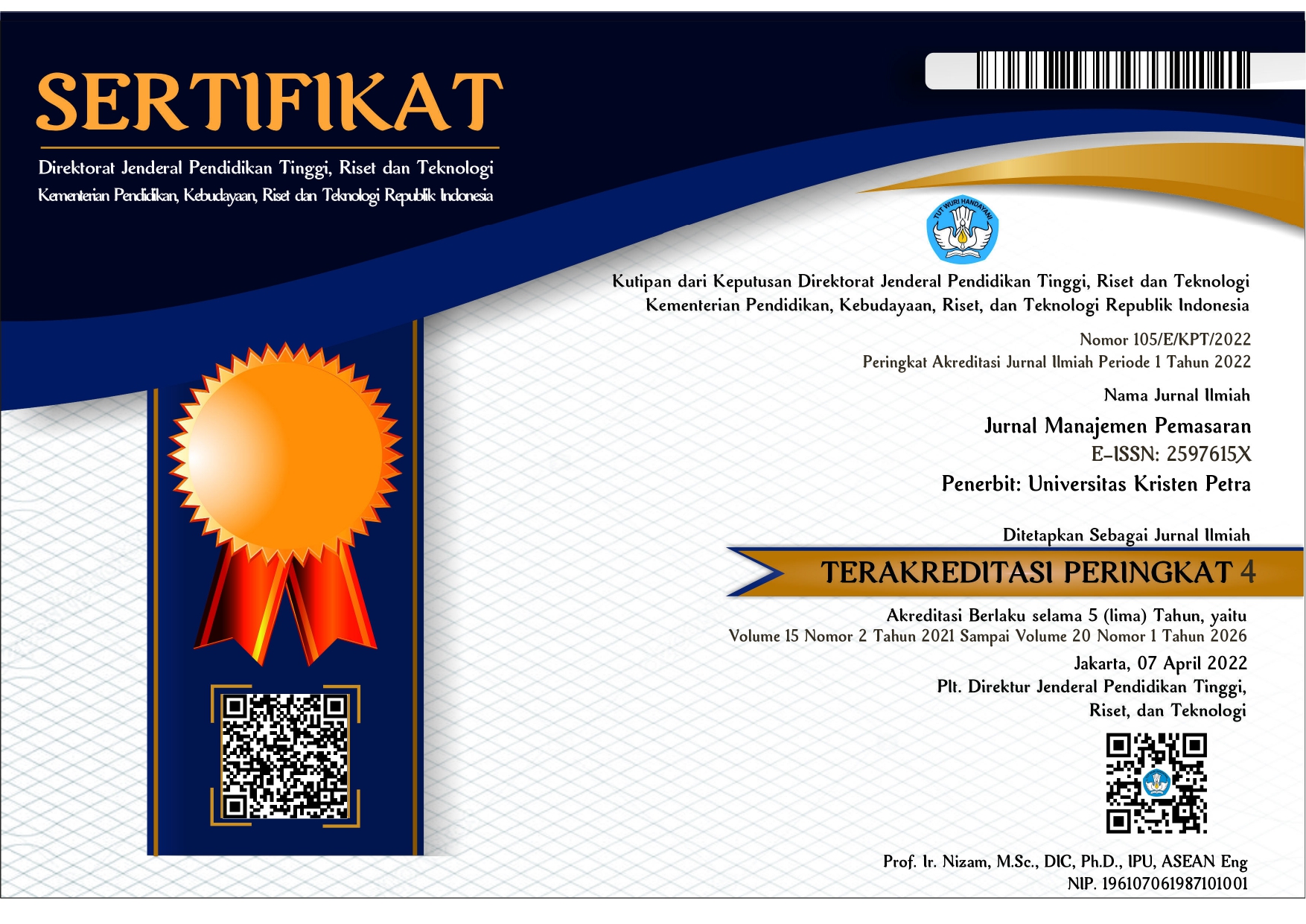PENGUJIAN EFISIENSI PASAR DAN TINGKAT KONVERGENSI HARGA KOMODITAS KOPI ARABIKA DAN KOPI ROBUSTA (Studi Kasus pada Pasar Komoditas Berjangka di Indonesia)
 :
:
https://doi.org/10.9744/pemasaran.9.2.43-53
Keywords:
Market efficiency, commodity, price convergence, hedging, risk premium, futures marketAbstract
This purpose of this paper is to test the market efficiency and the level of price convergence in the Arabica coffee and Robusta coffee commodity markets, which traded on the Jakarta Futures Exchange (JFX). Unit root test such as Augmented Dickey-Fuller (ADF) and Philip-Perron (PP) evidence that futures and spot prices are stasionary. Johansen Cointegration Test and Error Correction Model (ECM) provide that the Arabica coffee and Robusta coffee commodity markets in Indonesia is an efficient market and contain the risk premium. The result indicate that the Arabica coffee and Robusta coffee commodity markets has a high level of price convergence. The implication, market participants or investors still choose to do hedging activities because the utility of futures contracts as a hedge has been effective.References
Ali, J., & Gupta, K. B. (2011). Efficiency in agricultural commodity futures markets in India: Evidence from cointegration and causality tests. Agricultural Finance Review, 71(2), 162–178. http://doi.org/10.1108/00021461111152555
Ariefianto, M. D. (2012). Ekonometrika Esensi dan Aplikasi dengan Menggunakan EViews. Jakarta: Erlangga.
Arifin, Z. (2005). Teori Keuangan dan Pasar Modal. Yogyakarta: Ekonosia.
Ariyoso. (2009). Uji Akar Unit dengan Eviews. Retrieved from https://ariyoso.wordpress.com
Bappebti. (2012). Sekilas Tentang Perdagangan Berjangka Komoditi. Retrieved from http://www. bappebti.go.id
Batu, P. L. (2012). Buletin Bappebti. Retrieved from http://www.bappebti.go.id
Batu, P. L. (2014). Pasar Derivatif. Jakarta: PT Elex Media Komputindo Kompas Gramedia.
Bodie, Z., Kane, A., & Marcus, A. J. (2011). Invest-ments and Portfolio Management. 9th Edition, 96–97,102,103. Retrieved from http://www. amazon.co.uk/Investments-Portfolio-Management-Zvi-Bodie/dp/0071289143
Chance, D., & Brooks, R. (2013). An Introduction to Derivatives and Risk Management (9th ed.). Canada: South-Western Cengange Learning.
Fama, E. F. (1970). Efficient Capital Markets - A Review of Theory and Empirical Work.pdf. The Journal of Finance. http://doi.org/10.2307/ 2329297
Fama, E. F. (1991). Fama 1991. pdf. Journal of Finance.
Ghozali, I., & Ratmono, D. (2013). Analisis Multivariat dan Ekonometrika. Semarang: Badan Penerbit Universitas Diponegoro.
Hansen, L. P., & Hodrick, R. J. (1980). Forward Exchange Rates as Optimal Predictors of Future Spot Rates: An Econometric Analysis. Journal of Political Economy, 88(5), 829–853. http://doi.org/10.1086/260910
Haq, Irfan ul., Rao, K. C. (2014). Efficiency of Commodity Markets: A Study of Indian Agricultural Commodities. Pacific Business Review International, 7(2), 94.
Hull, J. C. (2011). Options, Futures, and Other Derivatives (8th ed.). Prentice-Hall.
Iyer, V., & Pillai, A. (2010). Price discovery and convergence in the Indian commodities market. Indian Growth and Development Review, 3(1), 53–61.
Kenourgios, D. F. (2005). Testing efficiency and the unbiasedness hypothesis of the emerging greek futures market. European Review of Economics and Finance, 4.
Kumar, B., & Pandey, A. (2013). Market efficiency in Indian commodity futures markets. Journal of Indian Business Research, 5(2), 101–121.
Lumintang. (2015). Menjadikan Indonesia Kiblat Harga Kopi Dunia. Retrieved from http://vibiz-news.com
Moholwa, M. B. (2005). Testing For Weak-Form Efficiency In South African Futures Markets For White And Yellow Maize. Department of Agricultural Economics. Michigan State University. Michigan State University.
Neto, O., & Garcia, F. (2013). The efficiency of the future market for Brazilian live cattle. Academia Revista Latinoamericana de Administracion, 26(2), 199–228.
Pennacchi, G. (2008). Theory of Asset Pricing. United States: Pearson Education.
Ranganathan, T., & Ananthakumar, U. (2014). Market efficiency in Indian soybean futures markets. International Journal of Emerging Markets, 9(4), 520–534.
Sabuhoro, J. B., & Larue, B. (1997). The market efficiency hypothesis: The case of coffee and cocoa futures. Agricultural Economics, 16(3), 171–184. http://doi.org/10.1016/S0169-5150 (97) 00003-0
Samal, G.V., Swain, A.K., Shoo, A., & Soni, A. (2015). Market Efficiency of Agricultural Commodity Futures in India: A Case of Selected Commodity Derivatives Traded On Ncdex During 2013. International Journal of Business and Management Invention, 4(1), 32–49.
Sathye, M. (2006). US Coffee “C” Futures: Some Results From Test of Co-integration and GARCH. Applied Econometrics and International Development, (6-3).
Sendhil, R., Sundaramoorthy, C., Venkatesh, P., & L., T. (2014). Testing market integration and convergence to the law of one price in Indian onions. African Journal of Agricultural Research, 9(40), 2975–2984.
Statistik, B. P. (2015). Produk Domestik Bruto (Lapangan Usaha). Retrieved from http://www. bps.go.id
Tandelilin, E. (2010). Portofolio dan Investasi Teori dan Aplikasi (1st ed.). Yogyakarta: KANISUS (Anggota IKAPI).
Wang, H. H., & Ke, B. (2005). Efficiency test of agricultural commodity futures markets in China. The Australian Journal of Agricultural and Resource Economics, 49, 125–141.
Widiastuti. (2012). Hedging Dalam Perdagangan Berjangka Komoditi. Retrieved from http://www. bappebti.go.id
Wijaya, J. (2005). Bursa Berjangka. Yogyakarta: ANDI.
Wikipedia. (2015). Bursa Komoditi dan Derivatif Indonesia. Retrieved from https://id.wikipedia. org
Wikipedia. (2016). Arbitrase. Retrieved from https:// id.wikipedia.org
Winarno, W. W. (2015). Analisis Ekonometrika dan Statistika Dengan EViews (4th ed.). Yogyakarta: UPP STIM YKPN.















